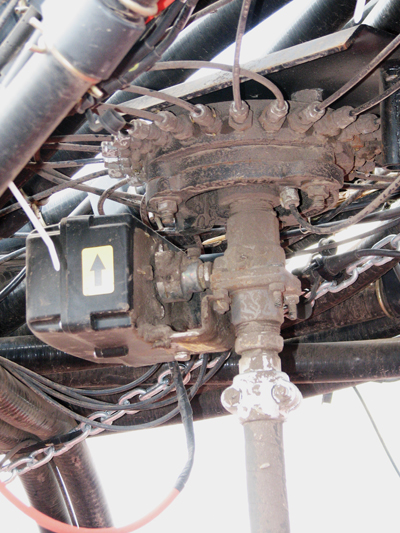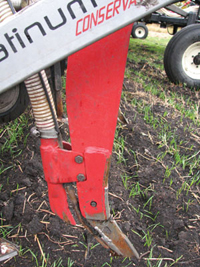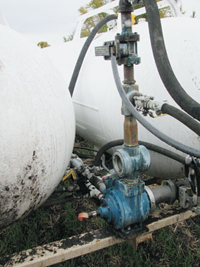
Features
Inoculants
Seed & Chemical
Efficient, stress-free NH3 delivery
Long one of the most economical means of supplying a crop with nitrogen, anhydrous ammonia (NH3) is saddled with safety concerns and application challenges. NH3 is typically placed into the soil as a gas, but it can dissipate quickly if not completely injected into the ground. Additionally, the cold temperature of the gas can cause frost to build in the lines or opener, further reducing application accuracy and efficiency.
December 3, 2008 By Rosalie Tennison
 |
| The NH3 distribution manifold with electric shutoff valve. Photos courtesy of Cam Stewart. |
Long one of the most economical means of supplying a crop with nitrogen, anhydrous ammonia (NH3) is saddled with safety concerns and application challenges. NH3 is typically placed into the soil as a gas, but it can dissipate quickly if not completely injected into the ground. Additionally, the cold temperature of the gas can cause frost to build in the lines or opener, further reducing application accuracy and efficiency.
“I always thought the hoses should be smaller on anhydrous applicators because it would keep the gas as a liquid,” comments Henry Hammer, a certified crop advisor in Fort Saskatchewan, Alberta. “Then, I found the Max-Quip system and I knew that I had been right!” A former producer, who became a crop consultant after working in the crop inputs field, Hammer still has a hands-on approach that finds him demonstrating the equipment in friend’s fields. He took time away from combining a field of grain that had nitrogen applied using Max-Quip’s Maxflow variable rate control (VRC) system to talk about how it works.
“The Maxflow system was installed on a Horsch-Anderson Air Drill this spring and we applied anhydrous without any freeze-up of the lines. With the old system we would be putting on 80 or 100 lbs of nitrogen, but with this system we only applied 70 lbs on canola and hard white wheat, and went down to 50 lbs of actual nitrogen on barley,” Hammer explains. “When we harvested the barley we took off 100 bu/ac.” He adds that applied rates of NH3 can be reduced by up to 20 percent and yield expectations can be met, which translates to a 20 percent reduction in fertilizer costs.
 |
| The NH3 tube on a ground opener. |
Hammer’s experience is in keeping with Max-Quip’s company literature. Based in Calgary, the company specializes in compressed gas delivery systems. “The Maxflow system is designed to deliver higher application rates and improved distribution accuracy over traditional manual and auto-rate control systems,” says company president Cameron Stewart. “This system can be used with many of the possible rate control systems available because it can interface with the controls of most manufacturers’ equipment. Progressive growers will be interested in how Maxflow can work with variable rate technology.”
The efficiency of the Maxflow system is highest when the pump is mounted as close to the outlet of the nurse tank as possible. A cooler is not required by the system, which eliminates the challenges inherent with plumbing vapour lines from the cooler to the opener. The pump speed is managed by an auto-rate controller, which interprets signals from a flow meter and ground speed indicator providing accurate application rates. “The rate can be adjusted on the go by making adjustments to the application in the rate controller,” Stewart explains. “Alternatively, the rate can be varied by a task controller with a prescription map and a GPS signal.”
He adds that an inline pressure-regulating valve keeps the NH3 in liquid form in the flow meter to ensure accurate measurement from the meter. “An on/off valve is installed at each manifold,” adds Hammer, “which gives it instant on and instant off that minimizes the chance of burning on the headlands.”

|
| The hydraulically driven positive displacement pump accurately meters out NH3.
|
The overall capacity of the system is between two and 2.5 per cent of the nurse tank’s storage capacity per minute. However, this can vary depending on temperatures of liquid, atmosphere and intake line restrictions. An example of this, according to Stewart, is a maximum withdrawal rate of 50 gallons per minute on a 2000 gallon nurse tank or 12,644 lbs of N per hour. “By keeping anhydrous as a liquid, you can get better accuracy,” continues Hammer. “The problem has always been that the hoses weren’t small enough, but the Maxflow system uses a 1/8-inch inside diameter hose.” The smaller hose creates a higher manifold pressure that improves distribution accuracy and maintains NH3 in liquid form.
Hammer says a basic kit for a 50-foot drill will cost between $18,000 to $20,000 and it is flexible enough to fit most drills without extensive adjustments. “The same manifolds can be used and the existing flow metre can be used. A good application for Maxflow would be on a precision seeder with a dual knife system because it will not freeze up.” He suggests that growers who are considering replacing their existing drill could add the Maxflow system to it because it will pay for itself in reduced volume of anhydrous ammonia needed, protect yield potential with accurate placement and minimized burn, and improved safety and peace of mind.
Stewart says 90 per cent of the systems Max-Quip sells are installed on hydraulically driven systems, but the remainder are on ground drive systems that have proven equally as accurate. However, he suggests, the move to variable rate technology makes the most sense because there are definite cost savings in the amount of product used and the accuracy of the application.
Finally, growers who rely on anhydrous ammonia as their main source of nitrogen can achieve the same level of accuracy and safety while maintaining yield potential as any dry or liquid application program. The safety and environmental protection benefits make it seem that much more appealing.